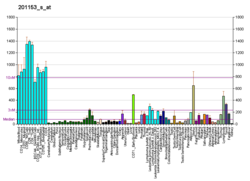Muscleblind Like Splicing Regulator 1 (MBNL1) is an RNA splicing protein that in humans is encoded by the MBNL1 gene. [5] [6] [7] It has a well characterized role in Myotonic dystrophy where impaired splicing disrupts muscle development and function. [8] In addition to regulating mRNA maturation of hundreds of genes MBNL1 (along with its paralogs MBNL2 & MBNL3) autoregulate alternative splicing of the MBNL1 pre-mRNA transcript. [9] The founding member of the human MBNL family of proteins was the Drosophila Muscleblind protein (PMID 9334280).
Human MBNL1 is an alternative splicing regulator that harbors dual function as both a repressor and activator for terminal muscle differentiation. [10] The repressive function of Human MBNL1 by sequestering at normal splice sites has been shown to lead to RNA-splicing defects that lead to muscular diseases. [11] The gene can be alternatively spliced into multiple functionally distinct isoforms, some of which linked to be involved in cancer biology. [12]
Human MBNL1 is a 370 amino acid protein [13] composed of four Zinc Finger protein domains of the CCCH type linked in tandem. [10] The MBNL1 protein specifically binds to double stranded CUG RNA expansions. [14] The Zinc Finger domains play a role in both protein:protein contacts as well as RNA:protein contacts when bound to an oligonucleotide. [10]







